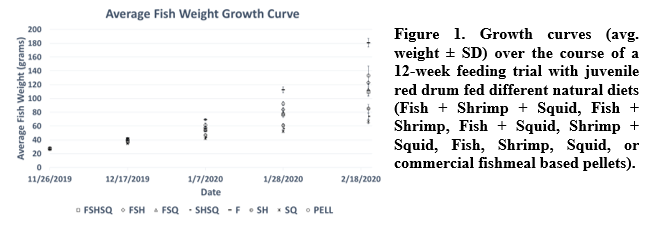NUTRITIONAL PERFORMANCE OF JUVENILE RED DRUM Sciaenops ocellatus FED VARIOUS FISH, SHRIMP, AND SQUID DIETS
Aquaculture continues to provide increased seafood production for human consumption. As production increases, it will become more important to identify and produce the most effective diets for grow-out. A 12 week feeding trial with juvenile red drum was conducted to determine performance of variations of the "gold standard" diet of fish, shrimp, and squid to identify if there is a better combination of these components for growth and health, which can provide information to develop fishmeal replacement diets (FMRD) that can closely mimic the performance of natural diets in fish growth. A 24-tank recirculating system was stocked with 25 fingerlings (27.45-gram average) in each tank. Eight diets containing fish, shrimp, and squid, and each single and double combination of these components, as well as a commercial fishmeal-based-diet were randomly assigned (3 tanks per diet) and fed isocalorically for the duration of the feeding trial based on biomass of each tank. Sampling occurred every 3 weeks, where 3 fish per tank were randomly selected and humanely euthanized, with livers, intestines, and muscle samples taken. Feeding amounts were adjusted based on new biomasses of each tank to ensure fish were fed isocalorically.
At the conclusion of the feeding trial, statistical analysis determined that there were significant differences in specific growth rate, hepatosomatic index, final average fish weight, final average total length, feed conversion ratio, and condition factor among the diets (p < 0.05). Figure 1 shows the differences in growth among the treatment groups. Three statistically different groups were observed using Tukey's post hoc testing based on final weight (p < 0.01). Fish was the highest performing natural component. The commercial fishmeal-based diet performed well across the board, showing it is well balanced nutritionally. Further work exploring the metabolomes of these tissues using nuclear magnetic resonance techniques will help explain why the fish component performed the best and help develop FMRD that produce high quality aquaculture fish.
